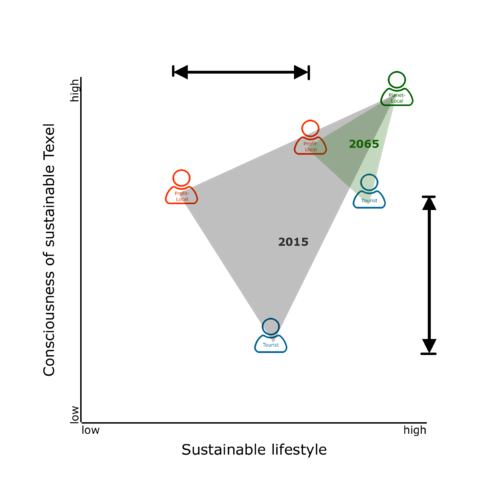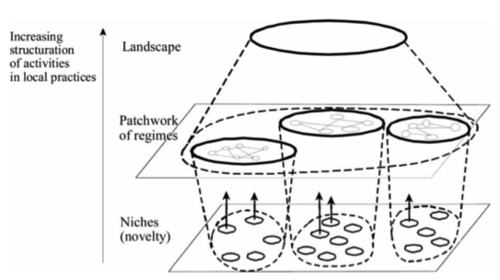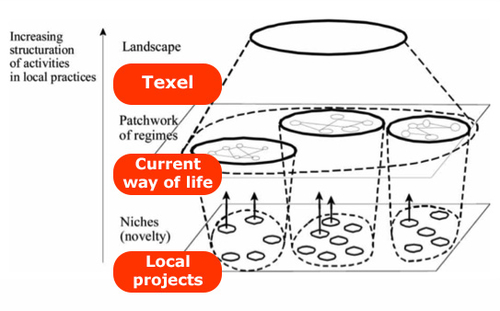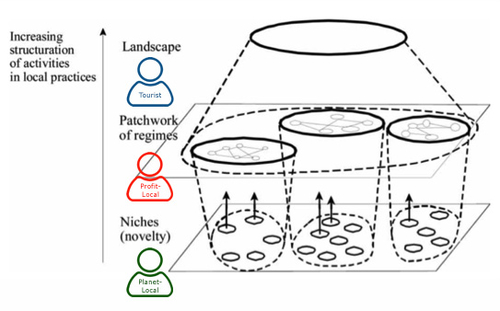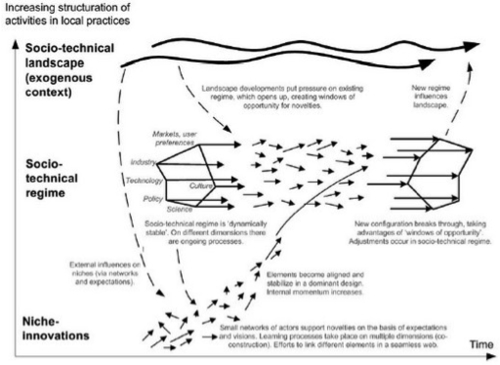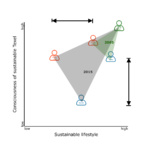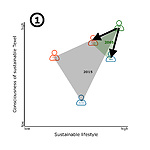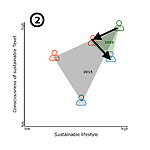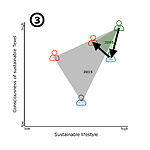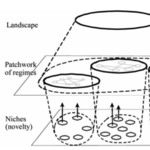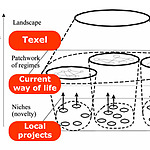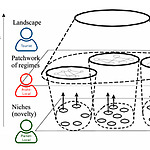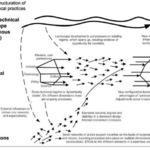In order to sustain lifestyles on Texel there should be a transition within these lifestyles that are identified in Texel’s’ society. In order to explain this transition a framework is set up in which the three lifestyles are ‘measured’ against two parameters for both the current and the future scenario. It should be noted that this measurement is relative, showed in figure 3.
The first parameter (horizontal axis) is the degree of ‘Sustainable Lifestyle’, this includes the level of sustainability within the daily activities, like the ways of waste disposal, saving energy, transport, etc. The second parameter (vertical axis) is the degree of ‘consciousness of sustainable Texel’, meaning the level of awareness and involvement in the sustainability initiatives on the island.
The framework shows that there is a contrast in the current and the future lifestyles on these two parameters. On the one hand for it is assumed that the Planet-Local already has a sustainable lifestyle, whereas the Profit-Local does have an unsustainable lifestyle and the Tourist is somewhere in between. On the other hand it is assumed that the Planet-Local already is very conscious of a sustainable Texel, whereas the Profit-Local is less conscious of this and the Tourist is not conscious.
The problem statement can be defined as: “In Texel’s’ society there is a contrast within the lifestyles of the Tourist, Profit-Local and Planet-Local on both the sustainability of these lifestyles and the consciousness of a sustainable Texel. A gradual shift in these lifestyles is needed in order to move towards a sustainable and 100% self-sufficient Texel in 2065.”
Interactions between the different lifestyles
In order to enable this gradual shift from the current to the future lifestyles, the interactions between the different lifestyles are highly relevant.
These interactions are mentioned in the definition Borras and Edler gave about the governance of change in Socio-Technical and Innovation Systems (ST&I). It is “the way in which societal and state actors intentionally interact in order to transform ST&I systems, by regulating issues of societal concern, defining the processes and direction of how technological artefacts and innovations are produced, and shaping how these are introduced, absorbed, diffused and used within society and economy” (2015, p. 14) Subsequently, they show their understanding that in these interactions tension can occur since actors have different normative values and material interest (Borras, Edler, 2015).
Therefore, it is useful to understand how these interactions lead to comfortable human habits. Social findings about how human environments are created show that a good natural environment is the basis for these comfortable human habits and arises partly by a good social climate too (Huang, 2008 p.577). It is of importance to research a dynamic framework that indicates how activities and processes can transform, or influence, the socio-structures wherein they are embedded, and vice versa. Because the rules that social groups share can be rooted in practices and artefacts too; Different social groups have differences in social rules and are collectively shared. (Geels, 2004).
It is assumed that there are different interactions between the different lifestyles. Three possible scenarios for these interactions are set up, these are described below, followed by a decision for the presumed scenario.
- Planet-Local influences both Profit-Local and Tourist (Figure 4)
In this scenario it is assumed that in the future sub-system the Planet-Local influences simultaneously both the Profit-Local and the Tourist. The Planet-Local could influence the Profit-Local by stimulating him to move towards a more sustainable Texel and especially by showing him the benefits of this, i.e. that the profit will increase when implementing sustainable initiatives. The Planet-Local could influence the Tourist by making the sustainable initiatives visible to him (for example by making attractions out of the sustainable initiatives).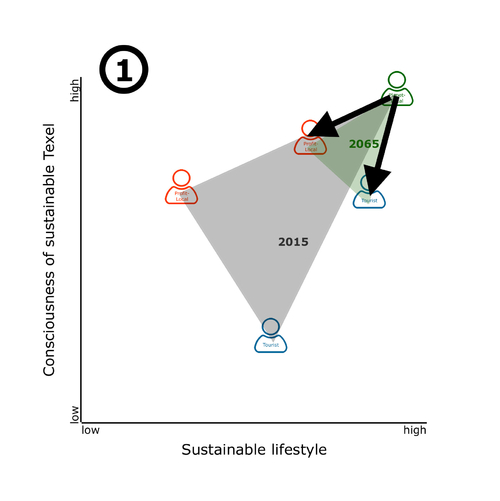
- Planet-Local influences Profit-Local, Profit-Local influences Tourist (Figure 5)
In this scenario the Planet-Local influences the Profit-Local similar to scenario 1. Subsequently the Profit-Local tries to make profit out of the sustainable initiatives (still in the tourist industry), and thus indirectly also influences the Tourist. In this scenario, the Tourist thus does not have to make a decision to move toward the sustainable lifestyle, but will be pushed towards that direction.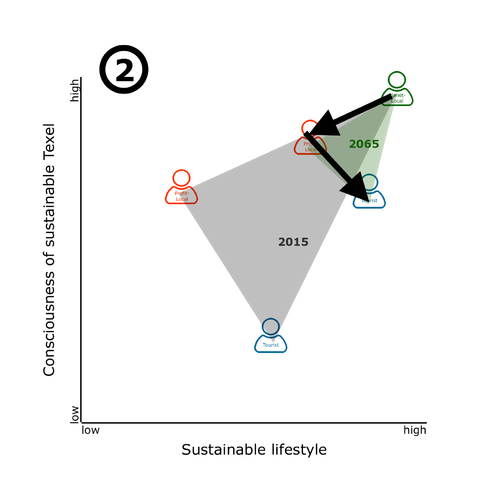
- Planet-Local influences Tourist, Tourist influences Profit-Local (Figure 6)
In this scenario the Planet-Local influences the Tourist, similar to scenario 1. It should be noted that the Tourist here still can make a decision whether to be influenced or not (the Tourist can also easily ignore the Planet-Local). Subsequently the Tourist influences the Profit-Local by demanding of sustainable lifestyle, the Profit-Local is assumed to follow the demands of the Tourists, in order to generate the highest profit.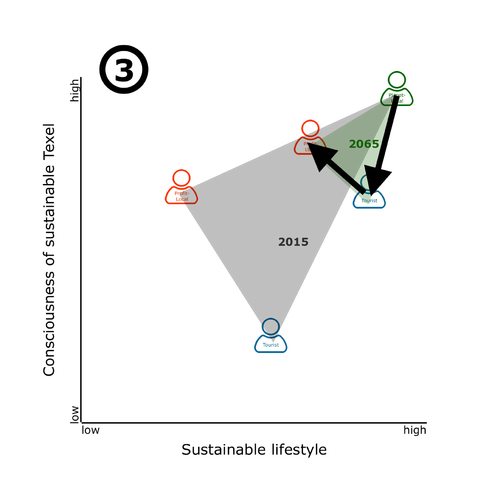
Presumed scenario
Scenario 2 (Planet-Local influences Profit-Local, Profit-Local influences Tourist) is presumed as the most realistic scenario for the future sub-system. This is mainly due to the strong position of the Profit-Local, if he moves towards a sustainable lifestyle, the Tourist will accordingly also move towards a sustainable lifestyle. Besides this, the Planet-Local is assumed to currently have a strong focus on Texel itself, rather than on the Tourists. This is enhanced by the fact that the Planet-Local can influence the Profit-Local all year round, since they all live on Texel. In contrast, the Planet-Local would only be able to influence the Tourist in summer, during the tourist season.
So the first step from the current to the future sub-system for a sustainable lifestyle the relation between the Planet-Local and the Profit-Local is highly relevant; the Planet-Local should influence the Profit-Local towards a sustainable lifestyle. In a later stage - when the Profit-Local made a shift towards a sustainable lifestyle - the influencing relation from the Profit-Local to the Tourist becomes relevant. This observation forms the foundation for the change towards a sustainable lifestyle, how to change will be discussed in the next paragraph.
How to change?
In order to create a change plan between now and the future of 2065, a strategy is needed how to influence the stakeholders in such a way that they start to interact and mutually grow towards the goal of a 100% self-sufficient Texel in 2065.
We believe that when it comes to changes in lifestyle, people will not be led top down, but want to have the perception that they can make their own choices. Especially when it comes to lifestyle it will need lot of time and persistency to change an attitude or perception.
Therefore, the Strategic Niche Management (SNM) of Schot & Van Geel as an approach as way to initiate the change is applied. Strategic Niches are ‘protected spaces that allow the experimentation with the co-evolution of technology, user practices, and regulatory structures’ (Geel & Schot, 2008). The Strategic Niche Management can be seen as a bottom–up process, in which novelties emerge in technological niches, then conquer market niches, and eventually replace and transform the regime. In the following figure you see the different layers of the sub-system as described by Schot & Van Geel. Clearly one can see the bottom-up approach, meaning that a change on landscape level can only be achieved by changes in the (socio-technical) regimes, which in turn are only influenced by niches.
Application of SNM on the system of Texel.
In this section it is zoomed in, using the SNM, on the system level of Texel and to the sub-system of sustainable lifestyle. First we look at system level:
The landscape is the island of Texel being ‘a geographical unity and social community’ (Gingerresearch.net, 2015). The Island is a part of the natural sanctuary ‘de Waddenzee’ and therefore an attractive island for tourists. Most of the tourist visit Texel because of its natural landscape and its flora and fauna.
The socio-technical regime can be defined as the current dominating way-of-life on Texel, focussed on semi-independency with only one connection to the main land through the ferry boat. The socio-technical regimes are highly influenced by the large tourist-industry on the island, resulting in a large amount of leisure-facilities and hotel- and catering industry. These facilities and industry can influence the landscape in a negative way, due to the use of environmental unfriendly products, waste, polluting transport- and energy-systems etc. Also other regimes exist like the farming and fishing regime, which can be seen in the landscape through large quantities of agricultural land and the presence of a fishing port at Oudeschilt.
Niches on system level are the local projects initiated by organisations or individuals, who try to diminish the negative environmental impact of the socio-technical regime on the landscape. Few of those projects are already identified in the ESD-course as sub-systems of their own, for instance sustainable transport, closing the water cycle, living with salination, etc (Gingerresearch.net, 2015). A practical example of such a niche is the AquaTX-project which is an initiative that wants to lessen the use of bottled water and promotes the use of tap-water in the leisure- and catering-industry. (AquaTX!, sd)
If we apply the upper description in the figure of Schot & Van Geel, the system of Texel can by seen in the adjacent figure.
Application of the SNM on the sub-system of sustainable lifestyle
If we now apply this model to the sub-system of sustainable lifestyle we see striking similarities with the upper system approach and the three lifestyle groups based on Elkingstons triple P approach of People, Profit and Planet from chapter one: the tourist, the local profit and the local planet.
As we described above we assume that there are strong interactions between the Planet-Local and the Profit-Local, and between the Profit-Local and the Tourist (scenario 2). Of course there will also be some influencing relation between the Planet-Local and the Tourist but this relation is considered of secondary importance.
Projecting these lifestyles on the hierarchy model of Schot & Van Geel we set the tourist on the landscape level because the group of the tourists is the largest of the three lifestyle groups and has only a short period of presence on the island. It also is assessed to be very heterogenic and having the lowest level of consciousness for a sustainable Texel (see figure 3 chapter 1). These factors combined make the tourist as the hardest group to change and therefore we place them at the landscape level.
On the intermediate, regime-level of the hierarchy model of Schot & Van Geel, the local profit is found. This lifestyle group is assessed to be largest group of the local population, making a living on what the island offers them. They are not very change minded, but are willing to change when they are convinced of the benefits of an innovation. We consider this group as neither very homogenic nor very heterogenic.
On the lowest level we place the smallest group, the local planet. We assess this group being more homogenic than the local profits and more change minded. This change is based on the intrinsic motivation to make Texel a more sustainable place to live. The sub-system lifestyle is projected on the adjacent picture.
How to get from 2015 to 2065
In the following graph from the paper of Schot & Van Geel you see the SNM approach applied on a time scale. The small arrows at the bottom can be seen niche activities or initiatives. Some of these niches will become a more dominant leading to a changes in the regime and some of these niches will not contribute to a regime-change. Only on the long run you see that regimes will change and can lead to changes on the landscape level.
Basically this means we want to use the local niche-projects of the local planets as a lever for change to influence in the socio-technical regime and eventually the socio-technical landscape.
Research question
Ultimately, this leads to the research question of this report:
“How could the interactions between the lifestyles of the Planet-Local and the Profit-Local in Texel’s’ society be positively influenced in such a way that they contribute to the gradual shift to a sustainable and 100% self-sufficient Texel in 2065?”
